23. The Influence of Bronze-Working on Roman Provincial Stone Sculpture: The Case of Palmyra
- Fred C. Albertson, University of Memphis, Tennessee
Abstract
The Roman-Syrian city of Palmyra is well known for its extensive corpus of surviving sculpture carved in the locally quarried limestone, dating from the early first century to the middle of the third century AD. Although bronze statuary was subordinate to stone as the Palmyran sculptor’s medium of choice, surviving fragments and inscriptional evidence document its existence in the city. However, an examination of Palmyran sculpture reveals that local artists included in their repertoire of stone-carving certain forms drawn from bronze prototypes and that these borrowings are more extensive than previously thought.
The more obvious features are incised grooves outlining the lips, deepened grooves beneath the corners of the mouth, and the sharply defined corkscrew curls with pointed tips found in male hairstyles. Additional features, previously attributed to Near Eastern traditions of stone-carving, may also be included among the group originating in bronze-working. One is the incision of the eyebrows as a herringbone pattern; another is the hollowing out of the iris as a circular cavity with a flat base, clearly intended for the insertion of a different material, which can now be identified as blue glass paste. All these features can be traced to the tradition of Graeco-Roman bronze statuary.
The Palmyran distinction is that the number of examples depicting these features drawn from bronze-working are relatively few and each adaption is chronologically short-lived and not necessarily contemporary, suggesting that their borrowing was not wholesale but selective, probably the result of decisions made by individual artisans or workshops.
The prosperity experienced by the elite of the ancient Roman-Syrian city of Palmyra from the late first century BC through the middle of the third century AD is perhaps most visible in their monumental family tombs and the funerary sculpture associated within these tombs. Among the types included within the well-known repertoire of Palmyran funerary reliefs are the distinctive loculus plaques: rectangular limestone slabs covering the burial cavity, carved in high relief with a bust depicting the individual interred and often accompanied by an Aramaic inscription denoting the occupant’s name, family lineage, and sometimes even the date of death. By about AD 200, the so-called “large banquet relief” and sarcophagi had also become mainstays within the Palmyran tomb.1
Palmyra’s wealth attracted and supported an active artistic community specializing in the carving of stone, specifically the locally quarried limestone. Yet this is a group that did not exist prior to the late first century BC and therefore had no previous local tradition from which to draw. The evolution of Palmyran sculpture and its portraiture is thus characterized by the borrowing of features from outside sources and the adaptation of forms and techniques to meet local tastes. Argued here is that one of these outside sources was contemporary Graeco-Roman bronze statuary.2
The physical evidence for the presence of bronze statuary at Palmyra is sparse. Only a handful of fragments remain: a sandaled foot with part of the lower leg from the Sanctuary of Bel; a section of drapery, a hand, and two feet clad in Parthian shoes from the Agora; and a miniature bust of a priest found in the Sanctuary of Nabû.3 The context would suggest that the use of bronze was normally confined to honorific statues erected in prominent public areas. A better claim for the wider use of bronze statuary at Palmyra comes from the Tariff Law of AD 137, specifically lines 128–30, which state that bronze statuary coming into the city was to be taxed the same as ordinary bronze, that is, one statue to be taxed based on half of its weight, two statues by the weight of one.4 These lines would seem to imply that bronze statues were being imported into the city in significant numbers, requiring them not only to be taxed but also to be qualified as to the manner by which they should be taxed.5
An examination of the surviving corpus of Palmyran sculpture, particularly that originating from a funerary context and dealing with images of the deceased, would strongly suggest that certain techniques employed on metal were then imitated and adapted by local stone carvers. The features examined here are limited to those that can be documented in works of bronze and are markedly absent in Roman marble sculpture. Such features occur in some 60 to 70 pieces, out of a surviving corpus of some 2,000 examples of Palmyran funerary sculpture.6
One prominent bronze feature seen in Palmyran stone sculpture is the incision of the eyebrows into a distinct herringbone pattern, sometimes referred to as caterpillar eyebrows (figs. 23.1–2).7 One might be tempted to propose a Near Eastern origin for such a rendering of the brows; portraits of Gudea of Lagash instantly come to mind.8 However, there is no evidence to document a continuity of such a form from the late third millennium BC to the early first millennium AD in the sculpture of the ancient Near East. Instead there are more obvious and chronologically closer examples of incised herringbone eyebrows in Graeco-Roman bronze statuary. Among the examples is a series of Gallo-Roman heads from the first century AD, including two bronze busts depicting male youths now in the Getty Villa (figs. 23.3–4).9 These can be supplemented by the bronze Doryphoros from the mid-first-century BC context of the Villa dei Papiri at Herculaneum.10 Within the realm of earlier Greek bronze statuary, the technique can be traced back through the Hellenistic to the late Classical period, as evidenced by the bronze head of a boxer from Olympia.11
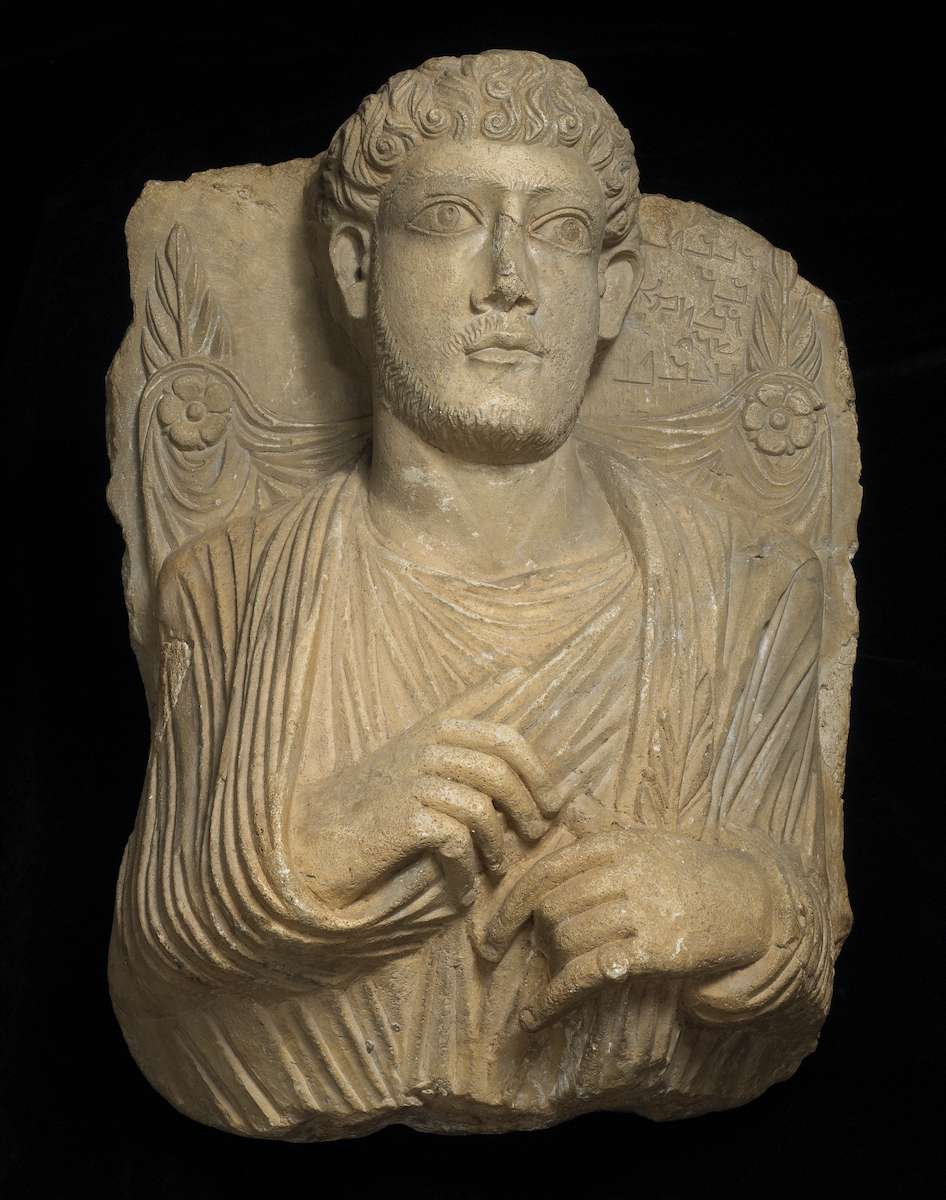

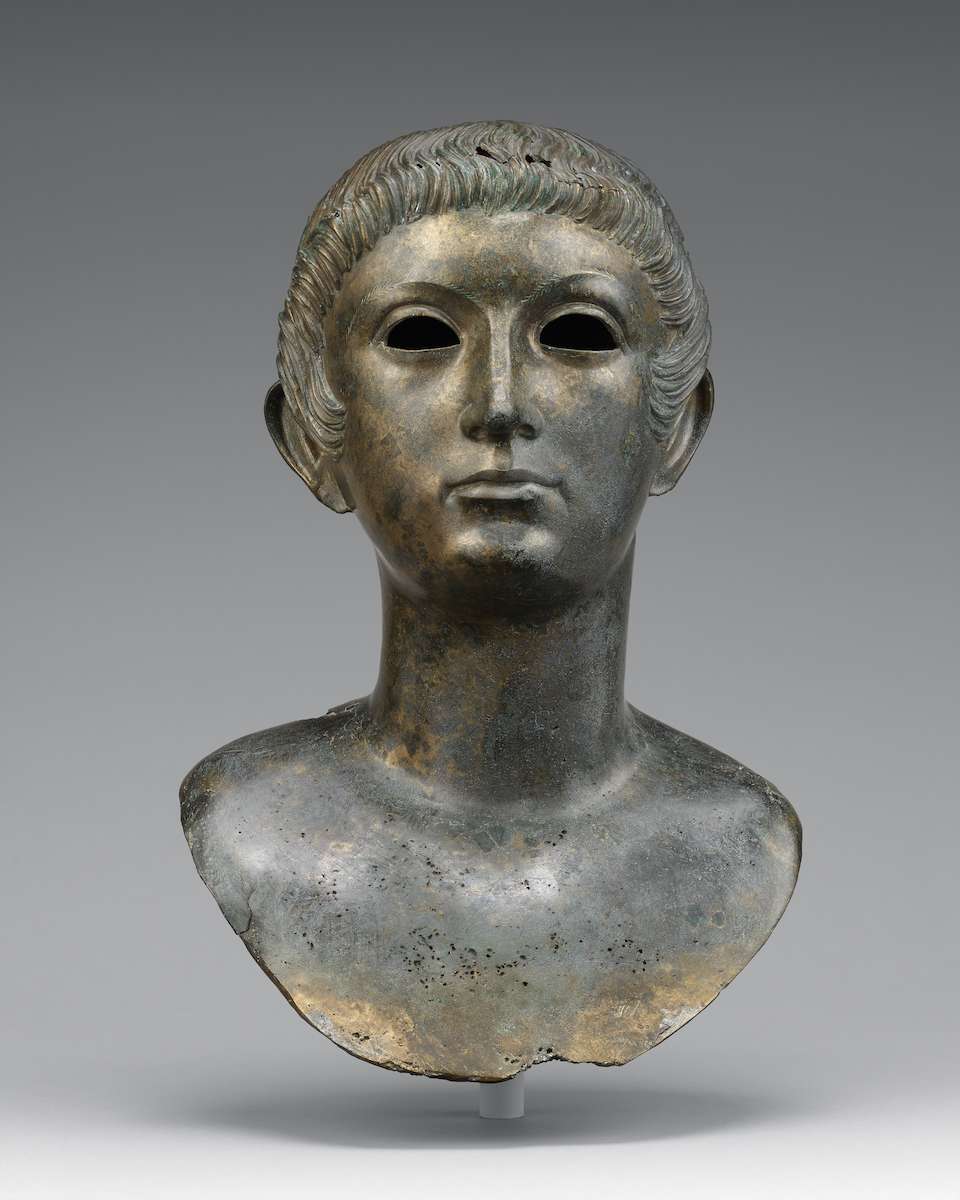

A second feature found in Palmyran limestone sculpture that was certainly borrowed from contemporary bronze sculpture is the use of glass paste for the iris and pupil, in place of the more common incised iris and drilled pupil, which were then painted. As seen on the so-called Beauty of Palmyra in Copenhagen, a loculus plaque belonging to an anonymous Palmyran matron carved approximately AD 200–210, what normally remains is a large circular cavity with an inner flattened surface (fig. 23.5).12 The flat surface of the cavity has caused scholars to speculate that such eyes when seen in Palmyran sculpture originally would have had inserted irises of another material.13 This assumption has proved to be correct, for among the series of ten surviving examples, one retains its original inserted eyes: a female head in the Los Angeles County Museum of Art (fig. 23.6).14 The extensively pitted material is glass paste, and its color, which appears black at first glance, is actually a dark blue. The insertion of the eyes as a separate entity has a long tradition in Greek statuary, but the insertion of only a circular iris has its best parallels in contemporary Roman statuary, most notably a series of Gallo-British examples, best illustrated by a recently discovered head of Marcus Aurelius now in the Ashmolean Museum (fig. 23.7).15 The fact that this technique may have been popular regionally in southeast Britain and northern Gaul does not rule out that the source is external and chronologically earlier. A bronze head of Hadrian, originally discovered in the Thames near London and currently in the British Museum, shows the method employed in official portraits of the emperors.16 Two Etruscan bronze portraits of male youths from Fiesole dating to the third century BC may be the evidence needed to trace this bronze-working method back to Italy.17
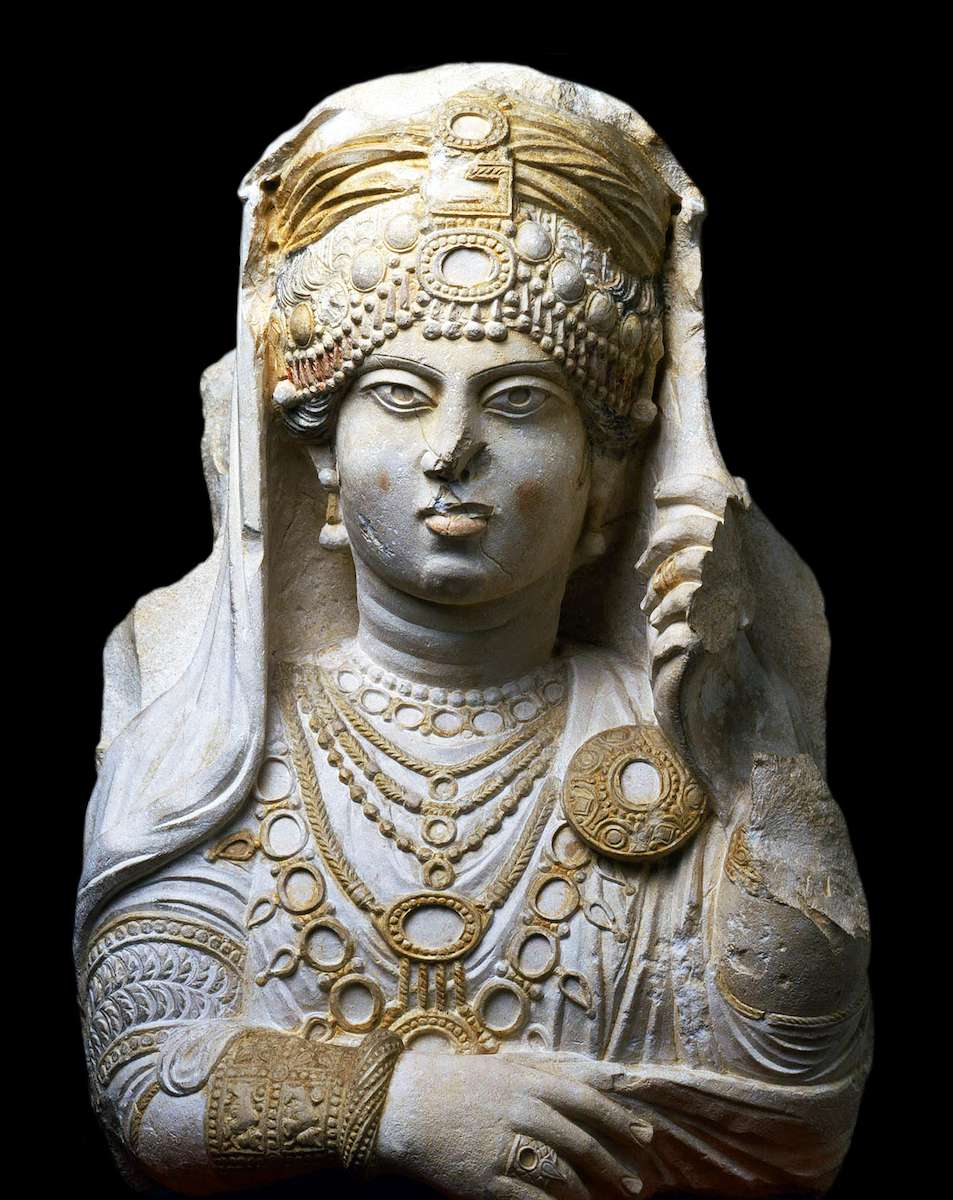
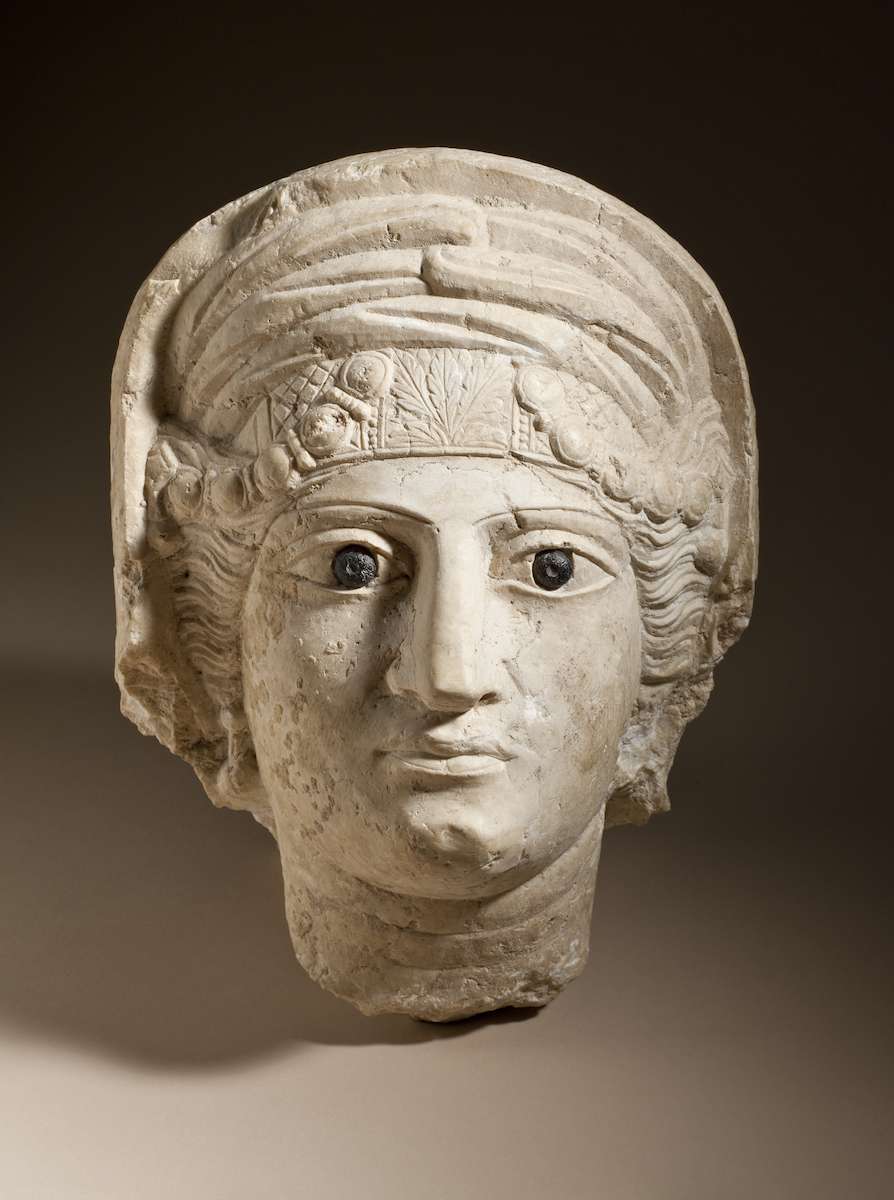
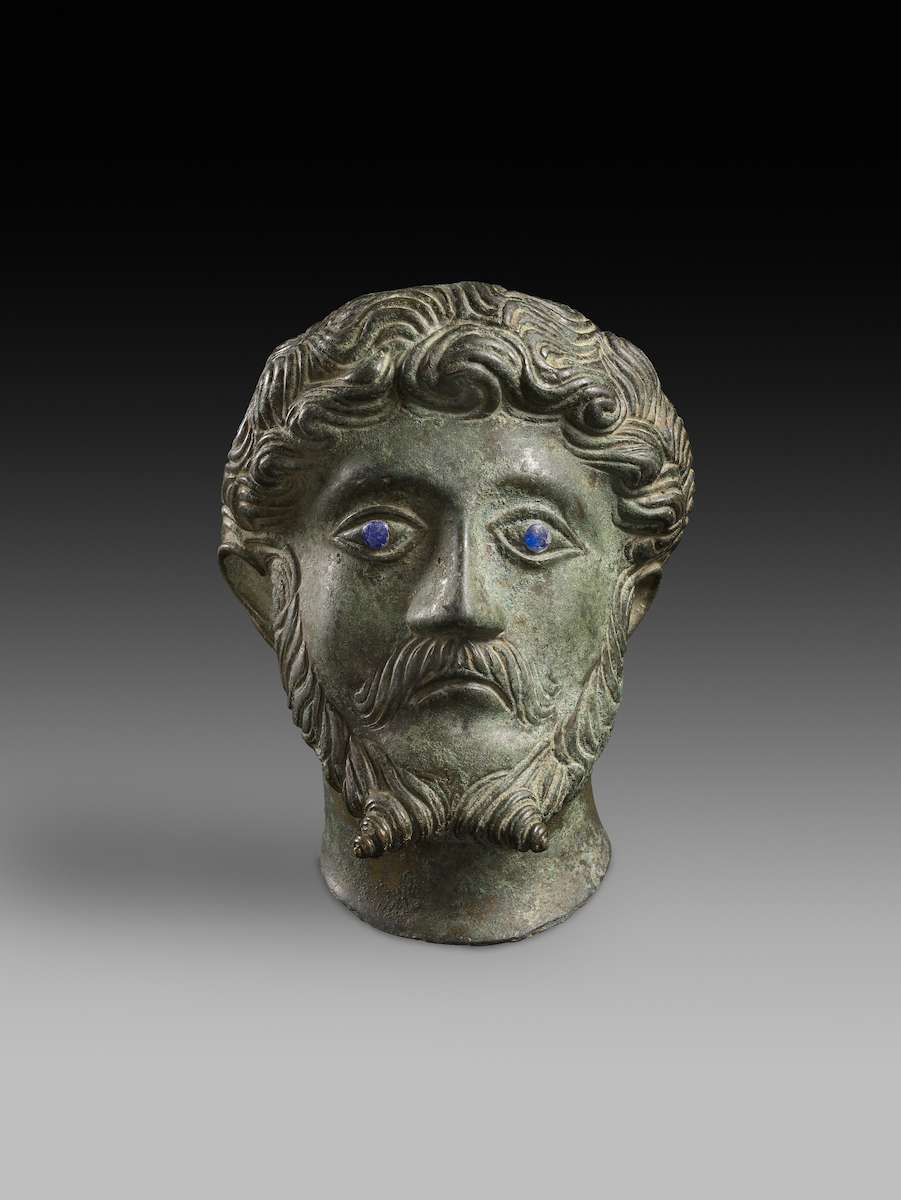
The third feature associated with Graeco-Roman bronze sculpture and adopted into Palmyran stone sculpture is the finely incised bordering of the lips, physically enhancing the vermilion border and often with a triangular recession denoting the depression between the lobes of the lower lip (see fig. 23.6). This technique is nearly absent in Roman marble portraiture but well known in bronze, as seen on the Croatian Apoxyomenos.18 This form in metalworking is surely intended to denote a separation of what would be copper lips from the surrounding bronze flesh, and its origins may stem from an early period when the mouth could be cast separately.19
While it seems clear that contemporary bronze statuary was the source for certain features seen in Palmyran limestone sculpture, perhaps the more intriguing questions are when and why this influence occurred. Here we are fortunate in that the methodology exists to date each example of Palmyran funerary sculpture relatively securely to within a 20–25 year span. Such a process is made possible by the existence of examples in which the date of the deceased’s death, and presumably then the date of the relief’s carving, is given in the accompanying inscription.20 The formulation of an absolute chronology is further assisted by intact tomb groups, where the genealogical context allows each funerary relief to be assigned to its respective generation.21 These datable examples then serve as chronological data points and, through a process of stylistic and typological comparison, allow the majority of undated examples to be dated. Consequently, a review of the chronology of those individual features discussed so far—herringbone eyebrows, inserted glass pastes for irises, and engraved lips—helps to shed light on the rationale behind the adoption of such features by Palmyran workshops.
Incised herringbone-shaped eyebrows can be documented on at least thirty-two examples at Palmyra (see Appendix 1). The form appears shortly after the middle of the second century. The earliest documented instance is the dated bust of ’Atê’aqab, in Istanbul, whose inscription gives AD 157 as the year of death.22 However, half of the examples cluster roughly between the years AD 180 and 210. After about AD 210, only a handful of examples appear. The last dated example is the relief of Ḥaggûr, son of Malkû, in the American University Museum, Beirut, inscribed AD 236–37.23 Of note is the fact that all the known examples represent males, suggesting that Palmyran sculptors consciously saw this manner of rendering the eyebrows as a gender signifier. In addition, at Palmyra the apex of the chevron of each individual eyebrow is pointed toward the bridge of the nose (see fig. 23.2), unlike that of any possible Mesopotamian or Graeco-Roman antecedent where the opposite direction is maintained (see fig. 23.4). This suggests a distinctively Palmyran adaptation of the form.
An inserted glass-paste iris and pupil makes its appearance within the Palmyran repertoire of forms in about AD 200. The Beauty of Palmyra in Copenhagen is the earliest (see fig. 23.5). One fragmentary loculus plaque of a woman24 and three female heads, all probably originating from large banquet reliefs and including the example in the Los Angeles County Museum of Art (see fig. 23.6),25 fall into the period around AD 200–220. The other five remaining examples are male; all are heads originally belonging to either statues or large banquet reliefs, and all date to about AD 230–50, more likely later in this period than earlier.26 Glass-paste eyes thus show an initial appearance in the Palmyran sculptors’ repertoire around AD 200–220, restricted at first to female portraiture. Then, perhaps after a brief pause, they reappear on male portraits for a short time toward the middle of the century.
The earliest documented use of incisions bordering and detailing the lips at Palmyra is from “the month of Ṭebet 466” (January AD 155), the date found on the inscription accompanying the loculus plaque of Bênnûr, son of Bar’â, in the Louvre.27 If we follow the examples listed by Gunhild Ploug, in her catalogue of Palmyran sculpture in the Ny Carlsberg Glyptotek, this relief and six others can be placed chronologically within the period of approximately AD 150–70.28 Eight of her examples fall in the later decades of AD 170–90.29 The fashion then quickly fades, with few examples appearing after about AD 200. It ultimately disappears by about AD 220.30
Our ability to date Palmyran sculpture rather accurately provides us with an unexpected result when dealing with the proposed influences of bronze on stone. One might expect the influence of bronze statuary to have a collective role; in other words, all the features with bronze antecedents making an appearance simultaneously, then existing side by side to some extent, and ultimately falling out of fashion altogether. Yet at Palmyra this is not the case. Incised lip outlines reach their highpoint of popularity around AD 170–90, then rapidly drop out of use. Incised herringbone eyebrows come into existence around the same time, and show the greatest period of use around AD 180–210, when the lip outlining is already on the decline. Glass-paste eyes appear some fifty years after the other bronze-working features, reaching a peak of popularity around AD 230–50, long after the others have essentially dropped out of use.
Surviving examples thus suggest that the borrowing from bronze statuary was not a wholesale process but one that was done piecemeal. Isolated, individual features were adopted from bronze-working and inserted into what remained a predominantly limestone tradition of carving. In addition, it is extremely rare for more than two of the bronze-derived features to appear together on the same portrait. Only two or perhaps three examples from the entire corpus of Palmyran funerary sculpture fall into this category, the head in the Los Angeles County Museum of Art being one.31 One could speculate that the allusion to bronze conferred a loftier status on the deceased’s image in stone. The large majority of the examples showing the influence of bronze-working fall into the category of “finer” works, that is, those characterized by a greater attention to detail, a softer modeling of features, and an overall finished appearance. Nevertheless, the chronology supports the idea that the process of selecting features from bronze statuary was random. This eclectic selection process in fact reflects the Palmyran sculptors’ entire approach. Analysis of Palmyran funerary reliefs has revealed that the sculptor began with a concept of a “portrait,” which the sculptor drew from a pre-established repertoire of forms. These forms guided the means of rendering the garments and the arrangement of their folds, the positioning of arms and hands, and the selection of attributes and personal adornment such as jewelry or hairstyle.32 Even what would normally be considered the distinct, individualized features of the subject—the facial features—are forms repeated from one portrait to another. This strict dependence on typology in Palmyran funerary sculpture sometimes resulted in the creation of identical images representing two different people and different images representing the same person.33
The study of Palmyran portraiture shows clearly that there was a continuous process of selection by the artist from a prescribed corpus of forms, perhaps due to the nature of the sculptural environment in which these reliefs were displayed and an emphasis on conveying the identity of the deceased, both as an individual and as a member of a larger community. What perhaps makes Palmyran portraiture so distinct is the fact that this repertoire of forms is constantly being augmented, with new forms drawn externally from Graeco-Roman art, including forms, as shown here, created in imitation of contemporary sculpture cast in bronze.
Appendix 1: Palmyran Reliefs with Incised Herringbone Eyebrows
Items are in chronological order; all are loculus plaques depicting males unless otherwise noted.
| Date (AD) | Example |
|---|---|
| 157 |
|
| 160 |
|
| 170 |
|
| 180 |
|
| 187 |
|
| 189 |
|
| 190 |
|
| 200 |
|
| 210 |
|
| 230 |
|
| 236–37 |
|
Notes
- For a general discussion, see Colledge 1976, 63–82. ↩
- Note previous connection made by Colledge 1976, 90, and Parlasca 1989, 206 n. 17. ↩
- Colledge 1976, 90 and n. 299, with bibliography. The hand from the Agora (Palmyra Museum, inv. 4801/1) is now published: Charles-Gaffiot et al. 2001, 329 no. 64, fig. on 212. ↩
- CIS, no. 3913, 128–30 (Palmyrene version); Matthews 1984, 180. ↩
- Colledge 1976, 190. ↩
- Kropp and Raja 2014, 393. ↩
- Illustrated here: Minneapolis, Minneapolis Institute of Art acc. 2008.28.2: CIS, 393 no. 4379; Sotheby’s 2002, lot 119. See Appendix 23.1 for additional examples. ↩
- Examples and illustrations of herringbone eyebrows: Johansen 1978, pls. 43, 44, 47, 59, 70, 71, 84, 92, 94, 97, 99, 101, 105, 113, and 120. They are also found, rarely, in Egyptian sculpture, as seen on the head of Senusret III from Karnak in the Luxor Museum: Romano 1979, 32–35 no. 40, figs. 28–31. ↩
- J. Paul Getty Museum, inv. 89.AB.67.1 and 89.AB.67.2 (illustrated here). Pollini 2001, with additional examples cited; note specific references to herringbone eyebrows on 137. ↩
- Naples, Museo Archeologico Nazionale inv. 4885. Daehner and Lapatin 2015, 296–97 no. 50. ↩
- Athens, National Archaeological Museum no. 6439. Mattusch 1996, 84–87, fig. 3.5. ↩
- Ny Carlsberg Glyptotek, inv. 2795: Ploug 1995, 188–92 no. 77. Such a form differs from similar large cavities for the iris appearing on other Palmyran examples (e.g., Ny Carlsberg Glyptotek, inv. 1151: Ploug 1995, 234–36 no. 103); in these instances, the hollow is concave and not as deep, and there seems to be a distinction here between the iris and the pupil. ↩
- Colledge 1976, 120; Ploug 1995, 190 and 229. ↩
- Los Angeles County Museum of Art, inv. M.82.77.2: Parlasca 1990, 140 no. 10, 139 fig. 10. ↩
- Ashmolean Museum, inv. AN2011.46; Walker 2008. It should be noted that both Colledge and Ploug (above, n. 13) tentatively suggest a Parthian source, citing inset eyes found on sculptures from Hatra. ↩
- British Museum, inv. BEP 1848,1103.1. Lahusen and Formigli 2001, 190–92 no. 114, figs. 114.1–4. ↩
- Paris, Louvre, inv. Br 19, and Florence, National Archaeological Museum, inv. 548: Lahusen and Formigli 2001, 18–19 no. 1, figs. 1.1–4; 20 no. 2, figs. 2.1–4; 462 and 466 figs. 1–3 (eyes). ↩
- Daehner and Lapatin 2015, 274–75 no. 41. ↩
- Mattusch 1988, 205. ↩
- Ploug 1995, 12–13. ↩
- Sadurska and Bounni 1994. ↩
- Istanbul Archaeological Museum, inv. 3840T: Ingholt 1928, 34–35 PS 11, plate 4; CIS, 476 no. 4616, plate 47. ↩
- Beirut, American University Museum, inv. 32.35: Ingholt 1934, 36–38 no. 3, plate 9.1. ↩
- First recorded in the collection of Guillaume Proche in Aleppo, illustrated by Chabot 1897, fig. 10. Present location not confirmed. Included in the series based on Ploug 1995, 229. ↩
- For the head in Los Angeles, see n. 14 above. The other two are: New York, Metropolitan Museum of Art acc. 65.77 (unpublished); and Palmyra Museum, inv. B2770/9254 (Charles-Gaffiot et al. 2001, 329 no. 66, fig. on 214). ↩
- Copenhagen, Ny Carlsberg Glyptotek, inv. 1117 (Ploug 1995, 238–39 no. 107); Copenhagen, Ny Carlsberg Glyptotek, inv. 1121 (Ploug 1995, 227–30 no. 97); Palmyra Museum, inv. B2727/9127 (Charles-Gaffiot et al. 2001, 367 no. 252, fig. on 311); Palmyra Museum, inv. B2726/9163 (Fortin 1999, 114 no. 64); Damascus, National Museum, inv. C18, in plaster (Tanabe 1986, plate 484 fig. 458; Charles-Gaffiot et al. 2001, 336 no. 99, fig. on 236). ↩
- Louvre inv. AO 2201. Dentzer-Feydy and Teixidor 1993, 185 no. 186. ↩
- Ploug 1995, 142. Another example may be added: London, British Museum 125022 (Ingholt 1928, 110 PS 180). ↩
- To which three more should be added: Grenoble, Musée de Grenoble, inv. 1578 (Ingholt 1928, 141 PS 442); Pittsfield, Berkshire Museum acc. 1903.7.3 (Albertson 2016, 159–60 fig. 7); Portland (OR), Portland Museum of Art acc. 54.2 (Parlasca 1990, 138–39, 136 fig. 5). ↩
- The last in the sequence, ca. AD 220, is the relief in Berlin, Staatliche Museen inv. VA 48 (Ingholt 1928, 149 PS 494). ↩
- The other two would be the relief in Minneapolis (see n. 7), combining incised outlining of the lips and herringbone eyebrows, and a plaster head in Damascus, National Museum, inv. C18 (see above n. 26), with herringbone eyebrows and glass-paste eyes. ↩
- Kropp and Raja 2014, 403; Albertson 2016, 153. ↩
- Discussed and examples cited in Kropp and Raja 2014, 403–4; Albertson 2016, 154–55. ↩
Bibliography
- Albertson 2016
- Albertson, F. 2016. “Typology, Attribution, and Identity in Palmyran Funerary Portraiture.” In The World of Palmyra, ed. Rubina Raja, 152–68. Scientia Danica, Serie H. Humanistica 4. Copenhagen: Royal Danish Academy of Sciences and Letters.
- Chabot 1897
- Chabot, J.-B. 1897. “Notes d’épigraphie et d’archéologie orientale.” JA 10: 308–55.
- Charles-Gaffiot et al. 2001
- Charles-Gaffiot, J., H. Lavagne, and J.-M. Hofman, eds. 2001. Moi, Zénobie, reine de Palmyre. Milan: Skira.
- Christie’s 2012
- Christie’s 2012. Antiquities. Auction catalogue 4925. April 26, 2012, London.
- CIS
- Corpus Inscriptionum Semiticarum. [1926] 1947. Part 2, vol. 3: Inscriptiones Palmyrenae, ed. J. B. Chabot. Paris: C. Klincksieck.
- Colledge 1976
- Colledge, M. A. R. 1976. The Art of Palmyra. Boulder: Westview Press.
- Daehner and Lapatin 2015
- Daehner, J., and K. Lapatin, eds. 2015. Power and Pathos: Bronze Sculpture of the Hellenistic World. Los Angeles: J. Paul Getty Museum.
- Dentzer-Feydy and Teixidor 1993
- Dentzer-Feydy, J., and J. Teixidor. 1993. Les antiquités de Palmyre au Musée du Louvre. Paris: Réunion des musées nationaux.
- Fortin 1999
- Fortin, M. 1999. Syria: Land of Civilizations. Trans. J. Macaulay. Montreal: Editions de l’Homme.
- Ingholt 1928
- Ingholt, H. 1928. Studier over Palmyrensk Skulptur. Copenhagen: C. A. Reitzels.
- Ingholt 1934
- Ingholt, H. 1934. “Palmyrene Sculptures in Beirut.” Berytus 1: 32–43.
- Johansen 1978
- Johansen, F. 1978. Statues of Gudea: Ancient and Modern. Mesopotamia 6. Copenhagen: Akademisk Forlag.
- Kropp and Raja 2014
- Kropp, A., and R. Raja. 2014. “The Palmyra Portrait Project.” Syria 91: 393–408.
- Lahusen and Formigli 2001
- Lahusen. F., and E. Formigli. 2001. Römische Bildnisse aus Bronze: Kunst und Technik. Munich: Hirmer.
- Matthews 1984
- Matthews, J. 1984. “The Tax Law of Palmyra: Evidence for Economic History in a City of the Roman East.” JRS 74: 157–80.
- Mattusch 1988
- Mattusch, C. 1988. Greek Bronze Statuary: From the Beginnings through the Fifth Century B.C. Ithaca: Cornell University Press.
- Mattusch 1996
- Mattusch, C. C. 1996. Classical Bronzes: The Art and Craft of Greek and Roman Statuary. Ithaca: Cornell University Press.
- Parlasca 1989
- Parlasca, K. 1989. “Palmyrenische Bildnisse aus dem Umkreis Zenobias.” In Festschrift für Robert Werner zu seinem 65. Geburtstag, ed. W. Dahlheim, W. Schuller, and J. von Ungern-Sternberg, 205–11. Xenia 22. Constance: Universitätsverlag.
- Parlasca 1990
- Parlasca, K. 1990. “Palmyrenische Skulpturen in Museen an der amerikanischen Westküste.” In Roman Funerary Monuments in the J. Paul Getty Museum, vol. 1, ed. M. True and G. Koch, 133–44. Occasional Papers on Antiquities 6. Malibu: J. Paul Getty Museum.
- Parlasca 2005
- Parlasca, K. 2005. “ Zu palmyrenischen Inschriften auf Reliefs.” In A Journey to Palmyra: Collected Essays to Remember Delbert R. Hillers, ed. D. Hillers and E. Cussini, 137–49. Leiden and Boston: Brill.
- Ploug 1995
- Ploug, G. 1995. Catalogue of the Palmyrene Sculptures: Ny Carlsberg Glyptotek. Copenhagen: Ny Carlsberg Glyptotek.
- Pollini 2001
- Pollini, J. 2001. “Two Bronze Portrait Busts of Slave-Boys from a Shrine of Cobannus in Roman Gaul.” In Studia Varia from the J. Paul Getty Museum, vol. 2, ed. M. True and M. Hart, 115–52. Occasional Papers on Antiquities of the J. Paul Getty Museum 10. Malibu: J. Paul Getty Museum.
- Romano 1979
- Romano, J. 1979. The Luxor Museum of Ancient Egyptian Art: Catalogue. Cairo: ASOR.
- Sadurska and Bounni 1994
- Sadurska, A., and A. Bounni. 1994. Les sculptures funéraires de Palmyre. RdA suppl. 13. Rome: G. Bretschneider.
- Sotheby’s 2002
- Sotheby’s. 2002. Antiquities. Auction catalogue 7858. December 11, 2002, New York.
- Sotheby’s 2007
- Sotheby’s. 2007. Egyptian, Classical and Western Asiatic Antiquities. Auction catalogue 8373. December 5, 2007, New York.
- Sotheby’s 2008
- Sotheby’s 2008. Egyptian, Classical and Western Asiatic Antiquities. Auction catalogue 8500. December 10, 2008, New York.
- Tanabe 1986
- Tanabe, K. 1986. Sculptures of Palmyra. Memoirs of the Ancient Orient Museum 1. Tokyo: Ancient Orient Museum.
- Walker 2014
- Walker, S. 2014. “Emperors and Deities in Rural Britain: A Copper-Alloy Head of Marcus Aurelius from Steane, near Brackley (Northants).” Britannia 45: 223–42.